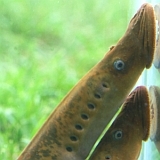 (Host) The state wants to hear from the public on how best to control lamprey that are blamed for killing fish in Lake Champlain.
(Host) The state wants to hear from the public on how best to control lamprey that are blamed for killing fish in Lake Champlain.
For years, the parasitic lamprey were thought to be an invasive species. Studies now show they are native to the lake. Still, fisheries managers say they are a nuisance, and they want to kill as many as possible.
VPR’s John Dillon reports:
(Dillon) Lamprey spawn in rivers and a chemical pesticide is used to kill their larvae in the streams. In the lake, lamprey attach to trout and suck out their blood.
The state is reconsidering how much pesticide to use. In announcing the decision, Natural Resources Secretary George Crombie called the lamprey "an invasive nuisance" that needs to be controlled.
But while lamprey may be a nuisance, they are not invasive, according to scientific studies. The research looked at DNA evidence that shows the lamprey became landlocked in Lake Champlain when glaciers retreated about 11-thousand years ago. A book on Vermont fishes published last year by the state also describes the lamprey as native to the lake.
Mike Winslow is a scientist with the Lake Champlain Committee.
He says it makes a difference whether lamprey are an invasive species – or native Vermonters that have lived for millennia in the big lake.
(Winslow) If it’s a non-native species then you pretty much would just as soon see them eradicated. If it’s a native species, you can still say the population is too high, and your management goals are somewhat different.
(Dillon) So Winslow says the state should try to control lamprey, not kill them off completely.
That’s not the opinion of many anglers on Lake Champlain. Steve McLeod is with the Vermont Traditions Coalition, which represents fishermen, hunters and trappers. McLeod says it doesn’t matter whether the lamprey evolved here.
(McLeod) Nah, it’s completely irrelevant. Vermonters are going to have to make a choice – and the Douglas Administration has to make a choice. Do we want a lake full of blood sucking parasites, or do we want a lake full of trout and salmon?
(Dillon) McLeod’s organization — and some fisheries biologists – complained that the level of pesticide that the state initially approved was too low to do the job.
So the Agency of Natural Resources re-opened the permit, and is seeking public comment. Laura Pelosi is director of policy research and planning.
(Pelosi) We’re going to go through this process. It’s significant. It’s important, and we’re going to do what we can to get it right.
(Dillon) The permits the state issued the first time would have allowed levels at 1-point-1 times the minimum lethal dose. Pelosi says officials now want to consider evidence that suggests that past treatments at that lower level may have not been effective.
(Pelosi) So we are taking a look at the data that has now been provided by the U-S Fish and Wildlife Service and the New York Department of Environmental Conservation. And we’re going to put that out for public comment…
(Dillon) The Poultney River contains a number of rare or endangered species that could be harmed by the chemical. And Mike Winslow of the Lake Champlain Committee questions if the state can legally increase the pesticide dose much above what it approved initially.
He says scientists haven’t really pinned down the reason why the lamprey are so out of balance in the lake.
But there are theories. One is that the original trout species that evolved along with the lamprey were wiped out a century ago by dams and over-fishing. And Winslow says humans may have made life easier for lamprey.
(Winslow) The substrate of a lot of these rivers could well have changed over time. We’ve dumped an awful lot of sediment into the rivers that’s moved downstream. And that sediment could provide ideal habitat for the developing lamprey.
(Dillon) The predators that used to eat lamprey – like eels and lake sturgeon – have also been virtually eliminated from the lake.
For VPR News, I’m John Dillon in Montpelier.